Introduction
Weather is not a capricious act of nature, but rather the atmosphere’s response to unequal rates of radiational heating and cooling across the surface of the Earth and within its atmosphere. The absorption of incoming solar radiation causes heating, while the emission of outgoing terrestrial radiation causes cooling. However, imbalances in the rate of heating and cooling create temperature gradients.2 Atmospheric circulations and weather are the atmosphere’s never-ending attempt to redistribute this heat and achieve equilibrium. This chapter provides a background on the interaction between the Earth and the atmosphere for a better understanding of the weather that will affect flight operations.
The Earth-Atmosphere Energy Balance
The Earth-atmosphere energy balance is the balance between incoming energy from the Sun (solar radiation) and outgoing energy from the Earth (terrestrial radiation), as seen in. When solar radiation reaches the Earth, some is reflected back to space by air (8 percent), clouds (17 percent), or the surface (6 percent). Some is absorbed by water vapor/dust/ozone (19 percent) or by clouds (4 percent). The remainder is absorbed by the Earth’s surface (46 percent).
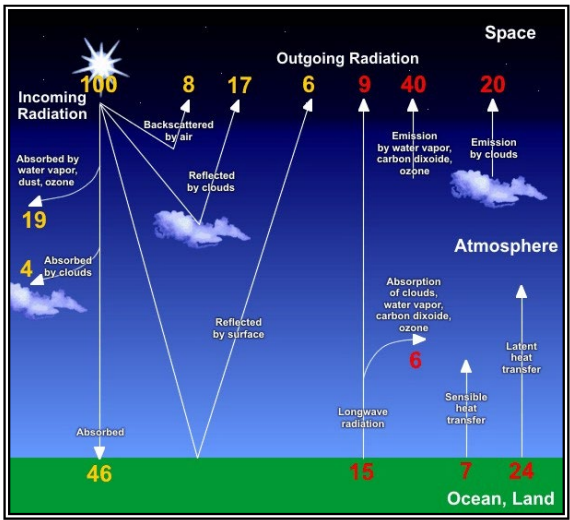
Figure. Earth-Atmosphere Energy Balance
In100 units of incoming radiation from the Sun is balanced by 100 units of outgoing radiation from the Earth.
However, since the Earth is much cooler than the Sun, its radiating energy is much weaker (long wavelength) infrared energy. Indirectly, this energy can be seen radiating into the atmosphere as heat (e.g., rising from a hot road, creating shimmers on hot sunny days). The Earth-atmosphere energy balance is achieved as the energy received from the Sun (solar radiation) balances the energy lost by the Earth back into space (terrestrial radiation). In this way, the Earth maintains a stable average temperature.
The absorption of infrared radiation trying to escape from the Earth back to space is particularly important to the global energy balance. Energy absorption by the atmosphere stores more energy near its surface than it would if there was no atmosphere. The average surface temperature of the Moon, which has no atmosphere, is -18 °C (0 °F). By contrast, the average surface temperature of the Earth is 15 °C (59 °F). This heating effect is called the greenhouse effect.
Greenhouse warming is enhanced during nights when the sky is overcast. Heat energy from the Earth can be trapped by clouds, leading to higher temperatures as compared to nights with clear skies. The air is not allowed to cool as much with overcast skies. Under partly cloudy skies, some heat is allowed to escape, and some remains trapped. Clear skies allow for the most cooling to take place.
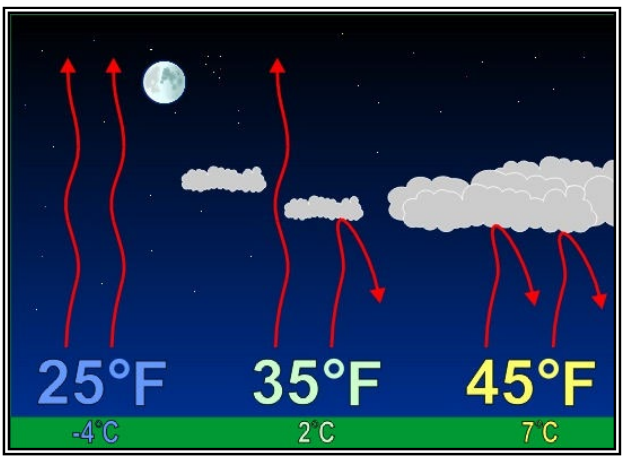
Figure. Greenhouse Effect on Nighttime Radiational Cooling
Heat Imbalances Between Earth’s Surface and the Atmosphere
The Earth-atmosphere energy balance numbers indicate that both sensible heat (7 percent) and latent heat (24 percent) processes transfer heat from the Earth’s surface into its atmosphere. Both processes are necessary to prevent the Earth’s surface from continually heating up and the atmosphere from continually cooling down.
Sensible Heating
Sensible heating involves both conduction and convection. It occurs due to differences in air density. Warm air is less dense than cool air.
On warm sunny days, the Earth’s surface is heated by incoming solar radiation or insolation. However, the heating is somewhat uneven because certain areas of the Earth’s surface absorb more heat from the Sun than others. Heat is conducted from the relatively warm ground to the cooler overlying air, which warms a shallow layer of air near the ground. The heated air expands, becomes less dense than the surrounding cooler air, and rises. Through this process, a large bubble of warm air called a thermal rises and transfers heat energy upwards. Cooler, denser air sinks toward the ground to replace the rising air. This cooler air becomes heated in turn, rises, and repeats the cycle.
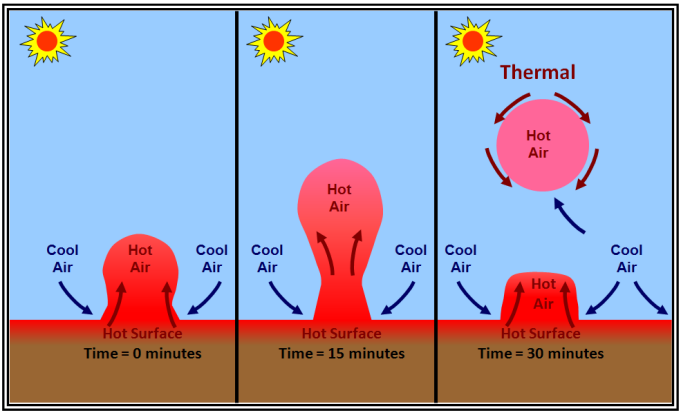
Figure. Development of a Thermal

Figure. Example of Convection in the Atmosphere
Latent Heat
The phase transition of water and associated latent heat exchanges are largely responsible for transferring the excess heat from the surface of the Earth into its atmosphere. As the Earth’s surface absorbs radiation, some of the heat produced is used to evaporate (vaporize) water from oceans, lakes, rivers, soil, and vegetation. The water absorbs heat energy due to the latent heat of vaporization. Some of this water vapor condenses to microscopic water droplets or deposits as ice crystals that are visible as clouds. During cloud formation, the water vapor changes state, and latent heat is released into the atmosphere. During this process, the excess heat is transferred from the Earth’s surface into its atmosphere.
Heat Imbalance Variations with Latitude
Global imbalances in radiational heating and cooling occur not only vertically between the Earth’s surface and its atmosphere, but also horizontally with latitude. Since the Earth is essentially spherical, parallel beams of incoming solar radiation strike lower latitudes more directly than higher latitudes; that is, the solar zenith angle is lower, and the Sun is more directly overhead in equatorial regions than at the poles. At higher latitudes, solar radiation is spread over a larger area and is less intense per unit surface area than at lower latitudes. Thus, the Earth absorbs more solar radiation at lower latitudes than higher latitudes, which creates heat imbalances and temperature gradients between the Equator and the poles.
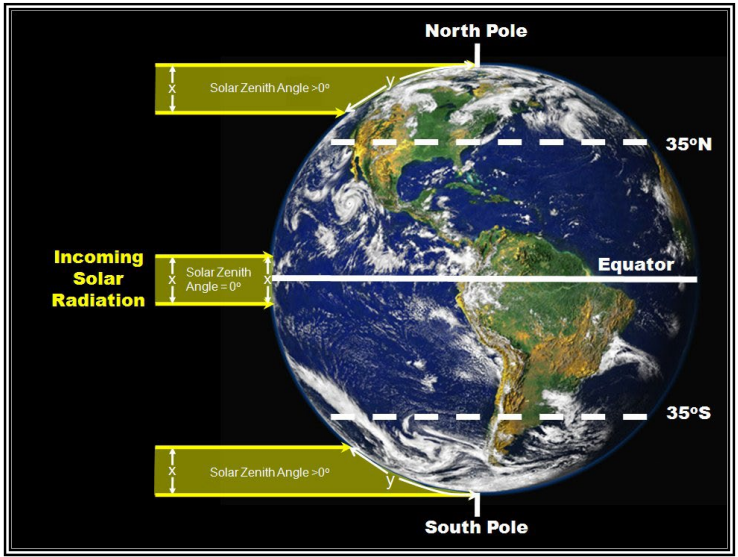
Figure. Solar Zenith Angle Variations with Latitude
The emission of terrestrial radiation also varies by latitude, but less so than the absorption of solar radiation. Terrestrial radiation emission decreases with increasing latitude due to a drop in temperature with latitude. Thus, at higher latitudes, the annual rate of cooling exceeds the rate of warming, while the reverse is true at lower latitudes.
Averaged over all latitudes, incoming solar radiation must equal outgoing terrestrial radiation. Otherwise, the Earth would be unable to maintain a constant average temperature. About 35° latitude in both hemispheres is where incoming and outgoing radiation is equal. This implies there is annual net cooling at higher latitudes and net warming at lower latitudes; however, this is untrue. The excess heat in the tropics must be transported polar by some mechanism(s). This poleward heat transport is accomplished by atmospheric circulations, weather, and ocean currents.
Seasons
Seasons are caused by the tilt of the Earth’s rotational axis as the Earth orbits the Sun . The Earth’s rotational axis is tilted by 23½° from the perpendicular drawn to the plane of the Earth’s orbit about the Sun and points the same direction in space all year long. The North Pole is tilted most directly toward the Sun during the summer solstice. Thus, in the Northern Hemisphere, the longest day of the year (lowest solar zenith angle) occurs on the summer solstice (approximately June 22), while the shortest day of the year (highest solar zenith angle) occurs on the winter solstice (approximately December 22). Day and night are of equal length (12 hours) worldwide on the vernal equinox (approximately March 21) and the autumnal equinox (approximately September 23).
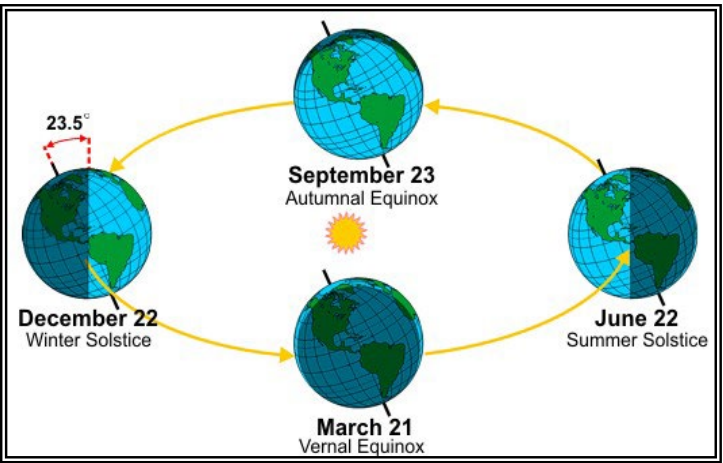
Figure. Solar Zenith Angle Variations with Northern Hemisphere Seasons
illustrates the average seasonal temperature variation in the Northern Hemisphere. Note that the warmest (coldest days) of the year occur after the summer (winter) solstice. This is due to the time lag necessary for heat flow processes to fully heat (cool) the surface of the Earth.
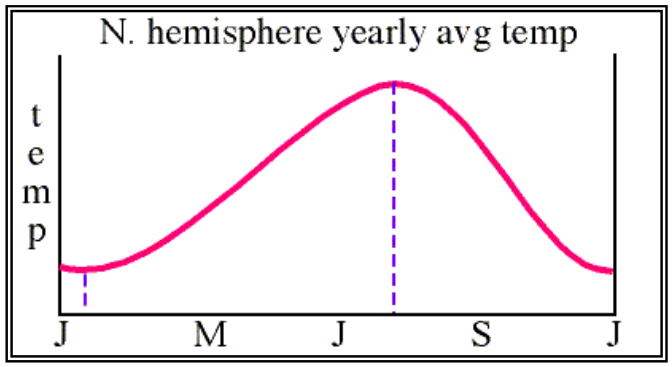
Figure . Average Seasonal Temperature Variation in the Northern Hemisphere
Diurnal Temperature Variation
Diurnal temperature variation is the daytime maximum and nighttime minimum of air temperature due to variations of insolation caused by the rising and setting of the Sun (i.e., variations of solar zenith angle) as the Earth rotates around its axis. depicts the typical diurnal temperature and radiation variations over land when the sky is clear.

Figure. Clear Sky Diurnal Temperature and Radiation Variations Over Land
Warming and cooling of the Earth depend on an imbalance between solar and terrestrial radiation. The Earth receives heat during the day through incoming solar radiation. It loses heat to space by outgoing terrestrial radiation both day and night.
Shortly after sunrise, incoming solar radiation received at the Earth’s surface (insolation) becomes greater than outgoing terrestrial radiation and the Earth’s surface warms. Peak insolation occurs around noon, but maximum surface air temperature usually occurs during the midafternoon. This lag is necessary for the air near the ground to heat up due to conduction and convection with the surface. The Earth begins to cool once the rate of outgoing terrestrial radiation exceeds the rate of insolation.
At night, insolation is absent, but outgoing terrestrial radiation continues and the Earth’s surface continues to cool. Cooling continues until shortly after sunrise, when incoming solar radiation once again exceeds outgoing terrestrial radiation. Minimum surface air temperature usually occurs shortly after sunrise.
The magnitude of diurnal temperature variation is primarily influenced by surface type, latitude, sky cover (e.g., clouds or pollutants), water vapor content of the air, and wind speed. Temperature variation is maximized over land, at low latitudes, with a clear sky, dry air, and light wind. Conversely, temperature variation is minimized over water, at high latitudes, with a cloudy sky, moist air, and strong wind.





